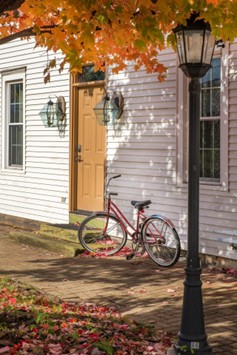
Your home’s exterior is constantly exposed to the forces of nature, and each season brings its own set of challenges. From the intense heat of summer and heavy autumn rains to freezing winter winds and spring pollen, seasonal changes contribute to wear and tear that, if neglected, can harm both your home’s appearance and its structural integrity. Knowing how each season affects your exterior surfaces is essential for effective maintenance and protecting your investment.
For a thorough seasonal refresh, professional services like Austin pressure washing can play a vital role in keeping your exterior clean and well-maintained. In the article below, we examine the specific effects of seasonal shifts on siding, roofing, gutters, windows, driveways, and more, while offering practical advice to help you preserve your home throughout the year.
Spring is a time of renewal, but for your home’s exterior, it also means facing several challenges:
Pollen and Allergens: Trees, flowers, and grasses release pollen that can coat siding, windows, and outdoor furniture, causing discoloration and potential staining.
Increased Rainfall: Spring showers increase moisture exposure, encouraging mold, mildew, and algae growth on shaded or damp surfaces.
Freeze-Thaw Residue: If winter ended abruptly, freeze-thaw cycles might have caused cracks in concrete and masonry surfaces.
Debris Accumulation: Winter debris such as dead leaves and twigs may still be clogging gutters and drains.
Thorough Exterior Cleaning: Remove pollen and dirt buildup by hiring a professional who uses gentle washing solutions specially designed for your siding material. This approach will brighten your home’s exterior and help prevent unsightly staining.
Inspect and Clear Gutters: Clean gutters and downspouts to ensure proper drainage and avoid water damage or mold growth.
Check for Damage: Look for cracks or gaps in concrete, stone, or siding caused by freeze-thaw cycles. Seal and repair as necessary to prevent worsening.
Trim Vegetation: Prune trees and shrubs away from your home to increase sunlight exposure and airflow, reducing moisture and mold risk.
Summer’s high temperatures and intense sun can cause multiple issues for your home’s exterior:
UV Damage: Prolonged sun exposure fades paint, dries out wood, and breaks down sealants, making surfaces brittle and prone to cracking.
Heat Expansion: Materials like wood, vinyl, and concrete expand under heat, which can cause warping, splitting, or loosening of panels and joints.
Storm Damage: Summer thunderstorms bring heavy rains and wind that can damage gutters, roofs, and windows.
Increased Biological Growth: Warmth combined with humidity encourages algae, mold, and mildew growth, especially in shaded or damp areas.
Apply Protective Coatings: Use UV-resistant paints and sealants on siding and wood surfaces to reduce sun damage and prolong lifespan.
Inspect and Repair: Regularly check for signs of warping, cracking, or loosened materials and address them promptly.
Maintain Gutters and Downspouts: Clear any summer debris like leaves and pollen to avoid blockages and water overflow.
Address Algae and Mold: Clean affected areas using appropriate cleaners and consider applying anti-microbial treatments for prevention.
Autumn brings colorful foliage and cooler weather but also presents challenges for your home’s exterior:
Leaf Buildup: Falling leaves can accumulate on roofs, gutters, and around the foundation, causing blockages and moisture retention.
Increased Moisture: Autumn rains and morning dew increase moisture exposure, promoting mold and mildew growth on siding and roof shingles.
Temperature Fluctuations: Daytime warmth followed by chilly nights can stress building materials through expansion and contraction.
Shorter Days: Reduced sunlight means less natural drying, leading to prolonged dampness on surfaces.
Clean Gutters and Roof: Regularly remove leaves and debris to prevent clogs and water damage. Consider installing gutter guards to reduce buildup.
Inspect Roof and Siding: Look for moss, mold, or algae and clean them off to avoid deterioration. Check shingles for looseness or damage.
Seal Cracks and Gaps: Use weather-resistant caulking to seal gaps around windows, doors, and siding to keep moisture and pests out.
Prepare Landscaping: Rake leaves away from the foundation and trim back plants to maintain airflow and reduce moisture trapping.

Winter exposes your home to the harshest weather conditions, which can be particularly damaging:
Freeze-Thaw Cycles: Water that seeps into cracks can freeze and expand, causing cracks in concrete, brick, siding, and roofing materials to widen.
Ice Dams: Ice buildup on roofs and gutters prevents proper drainage, leading to leaks and water damage inside walls and ceilings.
Frost and Snow Load: Heavy snow and frost accumulation can strain gutters, roofing, and structural components.
Salt and Deicing Chemicals: These agents used on driveways and walkways can corrode concrete and metal surfaces.
Inspect and Repair Before Freeze: Seal cracks and gaps before winter sets in to prevent water infiltration and freeze damage.
Maintain Roof and Gutters: Remove snow and ice safely and ensure gutters are clear to prevent ice dams. Professional roof inspections before winter can identify vulnerable spots.
Protect Exterior Pipes and Fixtures: Insulate exposed plumbing and outdoor faucets to prevent freezing and bursting.
Use Safe Deicing Products: Choose pet- and plant-friendly ice melt products to reduce damage to concrete and landscaping.
Regardless of the season, consistent maintenance is essential to keep your home’s exterior in top shape:
Regular Cleaning: Wash your siding, windows, and outdoor surfaces at least twice a year to remove dirt, biological growth, and pollutants.
Routine Inspections: Check for damage, wear, or signs of moisture intrusion quarterly and after severe weather events.
Maintain Drainage Systems: Keep gutters, downspouts, and drainage paths clear and functioning to avoid water damage.
Landscaping Management: Keep plants and trees trimmed away from your home to promote airflow and prevent moisture buildup.
Protective Treatments: Use paints, stains, sealants, and anti-microbial coatings appropriate to your exterior materials for added defense.
Each season brings its own challenges and stresses for your home’s exterior, but understanding these effects empowers you to take timely, effective action. From clearing spring pollen and addressing summer heat damage to preparing for autumn’s moisture and winter’s freeze-thaw cycles, a proactive maintenance routine helps protect your home’s beauty and structural integrity.
By investing time and effort into seasonal upkeep, you not only extend the life of your exterior surfaces but also enhance your property’s curb appeal and value. Whether you choose to do it yourself or enlist professional help, seasonal care is one of the smartest investments you can make in your home.